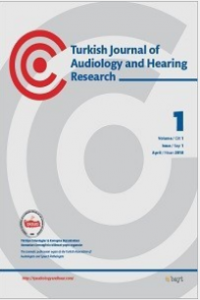Akıcı Konuşma Bozukluğunda Terapi Etkinliğinin Objektif Ses Analizi İle Değerlendirilmesi
Amaç: Akıcı konuşma bozukluklarında vokal kıvrımların lateral hareketindeki bozukluk nedeni ile meydana gelen kasılmalar objektif ses analizi parametrelerinin değişmesine neden olabilir. Akıcı Konuşma Bozukluğu olan bireylere uygulanan konuşma terapisi ile bireylerin hem konuşma akıcılığını arttırmak hem de ses şikayetlerinde gelişme yaratılabilir. Bu çalışmada, konuşma terapisinin objektif ses analizi üzerine etkisi araştırılmıştır. Gereç ve Yöntem: Bu çalışmada, 8-18 yaşları arasında kekemelik şikayeti ile başvuran 60 birey 31 kekemelik terapisi alan, 29 kekemelik terapisi almayan ve herhangi bir konuşma akıcılık problem olmayan 29 akıcı konuşan birey bulunmaktadır. Tüm gruptaki bireylere algı bozukluğu testi ve çok boyutlu ses analiz programı ile objektif ses analizi yapılmıştır. Bulgular: Bu çalışmada, terapi almayan kekeme grubun akustik parametre değerleri Jitter, Shimmer, Vti , kekemelik terapisi alan ve akıcı konuşan bireylerden daha yüksek bulunmuştur. Gruplar arasında yaş ve cinsiyet bakımından istatiksel olarak anlamlı bir farklılık bulunamamıştır. Sonuç: Akıcı konuşma bozukluğu olan bireylere uygulanan terapi bireylerin sadece konuşma akıcılığında değil, aynı zamanda konuşma akıcılığının sağlanmasında görev yapan objektif ses parametrelerin gelişimine katkı sağlamıştır.
Anahtar Kelimeler:
Akıcı konuşma bozukluğu, Akıcı Konuşma Terapisi, MDVP, Akustik Konuşma Parametreleri
Evaluation of The Therapy Effectiveness with Objective Sound Analysis in Dysfluency Individuals
Objective: The contractions that occur due to the defect in the lateral movement of the vocal fold during the stuttering period may lead to a change in the acoustic parameters of the individuals. with the therapy applied to stuttering individuals, both speech fluency and sound quality can be improved. In our study, it has been investigated whether stuttering therapy makes a difference in musical perception skills and acoustic parameters of individuals. Material and Method: In this study, we included 60 individuals 31 stutterers, 29 without stuttering therapy who were admitted to our clinic with stuttering between the ages of 8 and 18 and 29 fluent individuals without any speech fluency problems. Online tone perception disorder test and Multidimensional Voice Program analysis were performed to allthe individuals in the groups Result: In this study, the acoustic parameters of the stuttering group Jitter, Shimmer, Vti were found to be higher than those who had stuttering therapy and who were fluent. No statistically significant difference was found between the groups in terms of age and gender. Conclusion:Therapies applied to stuttering individuals not only improve speech fluency of individuals, but also contribute to the change of musical perception and acoustic speech parameters that serve to provide speech fluency
Keywords:
Dysfluency Dysfluency Theraphy, Tone deafness, MDVP, Acoustic Speech Parameters,
___
- Baken, R. J., & Orlikoff, R. F. (2000). Clinical measurement of speech and voice: Cengage Learning.
- Cappellari, V. M., & Cielo, C. A. (2008). Vocal acoustic characteristics in pre-school aged children. Revista Brasileira de Otorrinolaringologia, 74(2), 265-272.
- Conture, E. G., Colton, R. H., & Gleason, J. R. (1988). Selected Temporal Aspects Of Coordination Fluent Speech Of Young Stutterers. Journal of Speech and Hearing Research, 31, 653.
- Doğan, M., Nemli, N., Bayram, A., Kaya, A., & Yaşar, M. (2016). Findings of quality of life in children with stuttering ,”Kekeme çocukların yaşam kalitesi bulguları”. Official Journal of ENT-HNS Society of Istanbul.
- Hall, K. D., & Yairi, E. (1992). Fundamental frequency, jitter, and shimmer in preschoolers who stutter. Journal of Speech, Language, and Hearing Research, 35(5), 1002-1008.
- Levy, G. (2017). Could Voice Therapy be a Remedy for Stuttering? leaderlive. Max, L., & Baldwin, C. J. (2010). The role of motor learning in stuttering adaptation: Repeated versus novel utterances in a practice–retention paradigm. Journal of fluency disorders, 35(1), 33-43.
- Max, L., & Gracco, V. L. (2005). Coordination of oral and laryngeal movements in the perceptually fluent speech of adults who stutter. Journal of Speech, Language, and Hearing Research, 48(3), 524-542.
- Newman, P. W., Harris, R. W., & Hilton, L. M. (1989). Vocal jitter and shimmer in stuttering. Journal of fluency disorders, 14(2), 87-95.
- Perkins, W., & Kent, R. (1986). Functional Anatomy of Speech, Language and Hearing: A Primer. San Diego, CA: College. Hill Press. diagnosis and management. Annals of Otology, Rhinology, and Laryngology, 105, 851-856.
- Riley, G. (1994). Stuttering severity instrument for children and adults: Pro-ed. Salihović, N., Junuzović-žunić, L., Ibrahimagić, A., & Beganović, L. (2009)
- Characteristics of voice in stuttering children. Acta Med Sal, 38(2), 67-75.
- Schuster, S. H., & Schuster, F. M. (2012). A muscle spindle abnormity in one laryngeal muscle would be sufficient to cause stuttering. Medical hypotheses, 79(1), 34-37.
- Van Riper, C. (1982). The nature of stuttering: Prentice Hall.
- ISSN: 2651-3757
- Başlangıç: 2018
- Yayıncı: Odyoloji Konuşma ve Ses Bozuklukları Derneği
Sayıdaki Diğer Makaleler
Merve İKİZ, Merve Ozbal BATUK, Aysun Parlak KOCABAY, Betül Çiçek ÇINAR, Gonca SENNAROĞLU
Benign Paroksismal Pozisyonel Vertigo: Patofizyoloji, Değerlendirme ve Tanılama
Burak ÖZTÜRK, Münevver GÜLEÇ, Teslime Nur DEVECİ, Meryem Tuğçe GÜLER
Çocuklarda Eşdeğer Kulak Kanalı Hacmi Değerlerinin Yaşa Göre Değişiminin İncelenmesi
Samet KILIÇ, Betül Çiçek ÇINAR, Gonca SENNAROĞLU
Aysun Parlak KOCABAY, Betül Çiçek ÇINAR, Merve Ozbal BATUK, Gonca SENNAROĞLU
Akıcı Konuşma Bozukluğunda Terapi Etkinliğinin Objektif Ses Analizi İle Değerlendirilmesi
